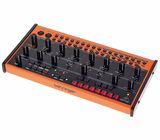Crave is a fully functional, semi-modular analog synthesizer with a really nice sequencer, for the price of a single modular filter... It's not a secret it clones Moog's mother32, up to the point where Moog's manual helps programming the sequencer (Behringer's short manual feels a bit chaotic). You can see comparisons between the two on yt, but that's completely not the point; neither is the often repeated "great for the price" - the success of (four times more expensive) mother32 makes the case this witty design of a synthesizer is just great, and price has nothing to do with it.
It is highly patchable: you don't see filter's resonance with CV input too often, yet this tiny machine has it... The VCO, VCF, VCA, LFO and the sequencer all have ins and outs. There are few utility modules as well: mixer/attenuator, noise generator, a multiple, and a "hidden" second LFO in the sequencer. All this encourages experimenting with synthesis much as any "large" modular would. The only thing lacking is sample&hold module.
I've learned some fun tricks with it (like VCF feedback for some distortion). It's fun to connect external gear (yes it is compatible with eurorack, 1V/oct and positive trigs), additional LFOs or a random voltage source for irregular sequencer resets. Some people claim the cheapest entry to modulars is getting two or three Craves and I can see this working nicely. Plugging another synthesizer as a sub-oscillator via external input works like a charm too.
The sequencer is a bit tricky to use (that's why it's worth to check out mother32's manual) and is limited to 32 steps: for most applications that's not a serious limitation as the sequences are transposable with either built-in keys or external keyboard.
The envelope is not a complete ADSR as D and R are controlled with the same knob. You can turn sustain off to get AD envelope instead. Sadly the envelope doesn't have CV ins (that would be wicked).
The filter (transistor ladder if you like that kind of stuff) besides usual low-pass has also a hi-pass mode (neat on higher resonance), and self-oscillates on a wide range of frequencies.
The LFO gets into audio range as well, though getting it tuned with the oscillator is doable only for a short frequency range (say 1 octave).
On the build quality: it's nice. The jacks are not screwed to the front-panel but so far sit well. Knobs are fine: you can twist them with one finger if you're busy, but you can also move them quite precisely. The built-in keys feel good to me. They are enough for transposing sequences with a left hand while playing the other synth with right one. Entering sequences from them is also fine, I rarely connect external keyboard to it. I've heard people complaining about clickiness, but somehow my unit is not that loud...
To sum up: it's a fantastic education/tinkering toy and a really nice, useful instrument with wide (and wild!) palette of sounds. After 9 months of everyday use I'm more than happy, I would buy it again, I would pay double that price too, and I do recommend it to everyone who wants to put their hands on semi-modular analog but don't want to invest into a large modular rack or (b)ARP 2600.


